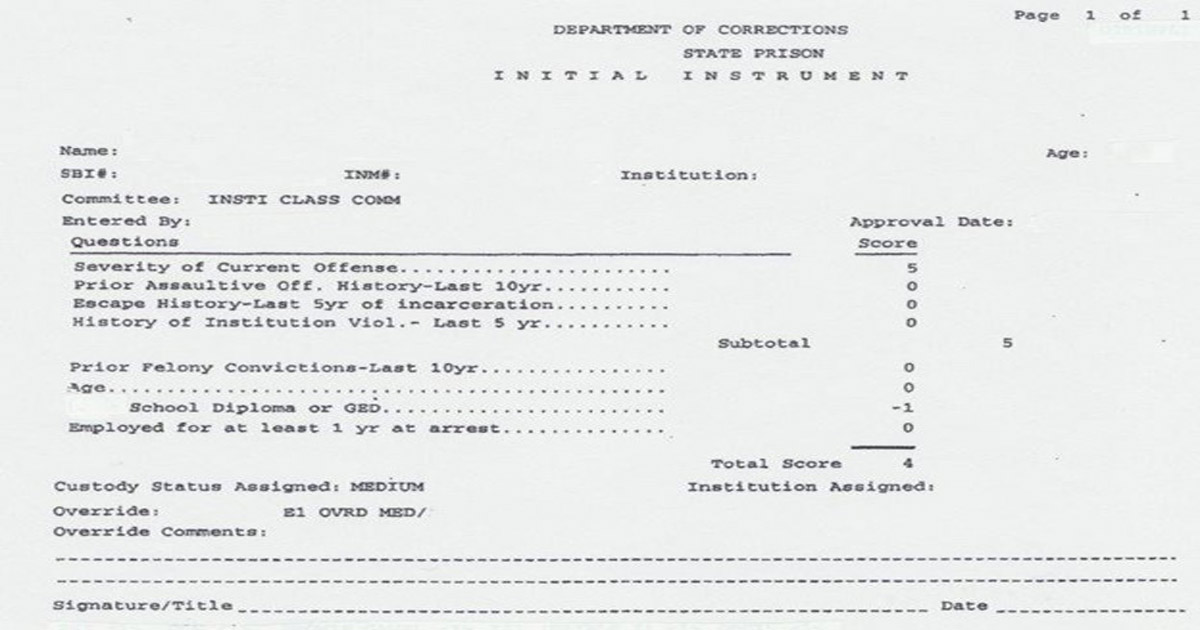The New Jersey Department of Correction’s Misuse of the E-1 Override in Classification Decisions and the Impact on Prison Designation, Programming, and Parole

Once committed to the State Prison system, the Department of Corrections (“DOC”) performs a classification assessment which has implications for an inmate’s prison designation, housing, rehabilitative programming, and ultimately, on parole. A recurring issue involves the application of an E-1 override which results in a minimum classification of “medium” or “maximum” custodial classification status despite the express terms of a plea agreement, a plea colloquy, and sentence.
An inmate may plead to a non-sexual, non-Megan’s Law offense, or a non-arson related offense, yet the DOC may impose an override based upon information from dismissed charges and/or allegations that were not the subject of and not admitted to at the time of the entry of a plea and conviction. It is important to understand the implications of an arbitrary application of an E-1 override as it imposes security restrictions based upon information that was not the basis of the conviction.
The Classification System, the Standardized Objective Assessment, and E-1 Overrides
An inmate’s initial classification evaluation is performed by the Central Reception and Assignment Facility (“CRAF”). An inmate may receive a security classification of close custody, maximum, medium, gang minimum, full minimum, or community custody. The ultimate classification provided has serious implications as to which prison an inmate will be designated, the permitted work assignments, rehabilitative and educational programming that will be permitted. Initial classification and an E-1 override will have a serious impact on an inmate’s parole considerations.
In determining classification, the DOC uses a standardized objective assessment protocol to determine an inmate’s security risk and to determine the appropriate security. When this standardized objective evaluation process determines a total score 4 or less, male inmates qualify as eligible for Minimum classification status.
The New Jersey Administrative Code under the “Objective Criteria for the Initial Instrument for Male Inmates” provides:
(a) Upon review of the inmate’s classification file, each of the criteria established in (c) below shall be assessed by a Technical Assistant or above and assigned points in accordance with the assessment scales indicated. The total points shall determine the custody status score on the Initial Instrument for Male Inmates as follows, except as established in (b) below: . . .
3. An inmate’s custody status score of four points or less shall indicate a recommendation for placement into minimum custody status. [N.J.A.C. 10A:9–2.4(a)(3)].
As documented in the Inmates Handbook:
C. Objective Classification (Except [Adult Diagnostic and Treatment Center] ADTC)
Through the OBJECTIVE CLASSIFICATION SYSTEM, inmates are given a standardized rating based on the following categories: current offense, history of violence, escape history, age, education, program participation, criminal history, disciplinary history and any applicable system code overrides. Each of the categories has its own separate score and when all of the category scores are combined, your Total Custody Score is determined.
– Male inmates who score 4 points or less will be assigned minimum custody. . . .
– Female inmates who score 6 points or less will be assigned minimum custody;
Please see pages 7-8 of the Inmate’s Handbook.
As part of this process, a DOC classification Technical Assistant may seek to override the standardized objective evaluation and request and receive approval for imposing an E-1 override. The imposition of an E-1 override permanently precludes a Minimum classification designation. An E-1 override is a “permanent custody prohibition/bar,” resulting in Medium or Maximum custody assignment “due to sexual or arson offense convictions.”
As part of the classification process, a DOC classification staff member might seek and receive authority for an E-1 override based only upon information that was not the subject of the plea or conviction, based upon dismissed charges, or from allegations in the official version or police reports. In the context of non-sexual endangering convictions, the staff member may assert that the convictions had “sexual overtones” even though the plea, the inmate’s factual basis, and conviction did not involve a sex offense. Similarly, the override might be applied in a situation where an inmate did not plead to arson, but there were dismissed arson charges and/or the official version in the pre-sentence report refers to allegations of arson.
Should a DOC E-1 Override Apply when a Defendant does Not Plea to a Sex or Arson Offense?
The question is whether the E-1 override should apply when a defendant does not plea to a sex or arson offense, but such charges were dismissed or the presentence report’s “official version” and/or police reports reference such allegations? The DOC has applied the E-1 override in cases where the plea, the factual basis, and the conviction do not reflect allegations of sex offense or arson.
The application of the E-1 override can be arbitrary and deny procedural fairness if it automatically precludes a reduced custody classification without a basis in the actual conviction and denies the inmate an objective consideration of whether Appellant actually poses the type of security risk to the prison system that precludes a Minimum classification.
At least one Appellate Division opinion has determined that in the context of a plea to a non-sexual second-degree conviction of endangering, it was arbitrary for the DOC to apply the E-1 override. M.K.O. v. New Jersey Dep’t of Corr., No. A-5598-17T3, 2020 WL 260903, at *4 unpublished opinion (N.J. Super. Ct. App. Div. Jan. 17, 2020) (Eric Marcy, Esq., argued, of counsel, and on the brief on behalf of MKO).
The Arbitrary Application of Overrides
While the determination of custodial classification is a privilege, a matter of discretion by the DOC, and our courts are to give a strong presumption of reasonableness to the DOC’s classification determination – the DOC’s determination is not absolute and a classification may be reversed if determined to be arbitrary. As one Appellate Division court noted:
Even if appellant’s file does contain those documents and the reasons for the override, we determine the DOC’s selection of parts of the cited documents, and its designation of same as the “official version,” was arbitrary and capricious. “Official version” is not defined in Chapter 9 of the Code. See N.J.A.C. 10A:9-1.3. The DOC culled select passages from certain documents in concluding what comprised the undefined standard of “official version.” Moreover, its finding was based upon allegations that the State could not prove or otherwise chose not to prosecute—charges that were ultimately dismissed. In doing so, it seemingly disregarded those portions of the regulations that allow an override in the case of inmates “serving sentences for” the enumerated offenses, N.J.A.C. 10A:9-4.7(a) (emphasis added), . . . N.J.A.C. 10A:9-4.7(c) (emphasis added).
M.K.O. v. New Jersey Dep’t of Corr, at *3.
It should also be noted that information contained in a pre-sentence report’s “official version” section has a very specific and clear disclaimer, i.e.:
Summary of the State’s Allegations
Disclaimer for Use in Post–Sentencing Proceedings:
This summary of the State’s Allegations includes descriptions of charges of which the defendant may not have been found guilty by a jury or may not have pled guilty to. No inference of guilt or wrongdoing should be drawn from dismissed charges. This section must be read in conjunction with the final charges and the “Defendant’s Version.”
The court in M.K.O., went on to note the importance of the plea colloquy given by the Defendant/Inmate at the time of the plea as critical as to whether an E-1 override should apply. If an individual did not enter a plea and provide a factual basis for sex or arson offense – the E-1 override should not be imposed.
The Bottom Line on the E-1 Override
Classification is critical to determining where an inmate will be incarcerated, what rehabilitative programming may be available, and will have an impact on parole consideration down the road. An inmate’s classification status, housing, work, and rehabilitation programming are key issues in parole consideration. Having a higher level of classification than what the objective score allows, being housed in a higher security unit or prison, and being denied participation in work and/or programming due to a medium or maximum classification, will significantly impact an inmate at the time one becomes eligible for parole.
Whenever an inmate scores a level that allows for minimum custody and any override is imposed, it is important to review the override and the underlying basis for the override, to determine whether the application is unsupported by the record, and/or is arbitrary.
Our criminal defense and parole lawyers at Lyons & Associates, P.C. will vigorously defend you as you go through the criminal justice and parole process. Call us at 908-575-9777 or contact us online today to schedule a free consultation. We have offices located in Somerville and Morristown, New Jersey, and represent clients throughout New Jersey including, but not limited to, clients throughout Somerset County, Morris County, Middlesex County, Union County, Essex County, Bergen County, Hunterdon County, Warren County, Sussex County, Passaic County, and Monmouth County.
References:
M.K.O. v. New Jersey Dep’t of Corr., No. A-5598-17T3, M.K.O. v. New Jersey Dep’t of Corr., 2020 N.J. Super. Unpub. LEXIS 116, unpublished opinion (N.J. Super. Ct. App. Div. Jan. 17, 2020) (Eric Marcy, Esq., argued, of counsel, and on the brief on behalf of MKO).
Henry v. Rahway State Prison, 81 N.J. 571, 579-80 (1980)
Smith v. Ricci, 89 N.J. 514, 525 (1982)
State v. Johnson, 42 N.J. 146, 159 (1964)
https://www.law.umich.edu/special/policyclearinghouse/Documents/New%20Jersey%20Inmate%20Handbook.pdf
N.J.A.C. 10A:9-1.3
N.J.A.C. 10A:9-2.2
N.J.A.C. 10A:9–2.4
N.J.A.C. 10A:9-2.4(a)(3)
N.J.A.C. 10A:9-2.14(a)(4)
N.J.A.C. 10A:9-2.14(a)(5)
N.J.A.C. 10A:9-4.7(a)


